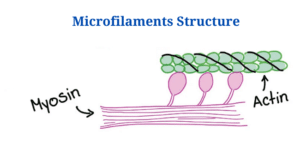Definition of Microfilaments
Microfilaments, often referred as actin filaments, are components of a cell’s cytoskeleton.
- It is made up of two parallel polymers of G-actin that are coiled around each other in a helical configuration and have a diameter of 6 to 8 nanometers each.
- These filaments, which are found in all eukaryotic cells, have a structural purpose and are a key component of the cytoskeleton, alongside microtubules and, in some cases, intermediate filaments. Microfilaments are the tiniest filaments in the cytoskeleton.
- Cytokinesis, amoeboid movement, general cell motility, changes in shape of the cell, endocytosis and exocytosis, cell contractility, and mechanical stability are only a few of their functions.
Microfilaments Diagram
Microfilaments Structure
- In cells, a variety of proteins interact with and change microfilaments.
- Actin is initially synthesised mostly by cell in a globular shape. Instead, they seem as elongated polymerized chains of molecules linked to form an F-actin filamentous structure.
- As a result, they are made up of two spiralling strands of actin subunits. Filamentous actin is made up of actin subunits which combine to produce a microfilament (F-actin).
- These filaments have a diameter of about 7 nanometers, which makes them the thinnest filaments in the cytoskeleton.
- These linear filaments are stronger and more resistant to crushing and buckling, despite their suppleness.
- Like microtubules, they’re polar. There is a pointed minus end and a barbed plus end.
- Polarisation is caused by a molecular binding pattern in the molecules which make the microfilament. The positive end of the molecule increases more rapidly than the negative end, just like microtubules.
- The cell’s movement is aided by an overall strong and flexible structure.
- Typically, they develop at the plasma membrane. As a result, the concentration of microfilaments is highest near the cell’s periphery.
- Microfilament characteristics are altered by external variables and specific proteins, allowing them to make fast alterations when required, even though the filaments must always be totally disassembled inside one region of the cell and assembled again in the other.
- Microfilaments are considered to be part of the cell cortex, that governs cell shape and mobility, after they are detected underneath the plasma membrane.
Formation of Microfilaments
A microfilament is formed when three G-actin proteins combine to create a trimer. Additional actin is then coupled to the protein’s barbed end. Autoclampin proteins, which function as motors, make it easier to assemble microfilaments. Two long actin strands are spiralled together to form the actin microfilament.
Microfilaments Functions
- Myosin and microfilaments work together to generate forces that allow cells to contract and move.
- Eukaryotic cells depend heavily just on stability of their actin filaments to survive because they are exposed to so many threats.
- Microfilaments are required for the formation of all cell surface projections such as filopodia, lamellipodia, and stereocilia. They are indeed engaged in the motions of amoebic cells.
- Microfilaments also assist mitotic cell division (cell division). During cytokinesis, for example, microfilaments assist the cell in “pinching off” and physically separating into two daughter cells.
- Microfilaments make up the cytoskeleton, that keep organelles in place inside a cell. They offer cellular rigidity and shape.
- Depolymerizing (disassembling) and quickly reconstructing a cell can change its structure and mobility.
Click Here for Complete Biology Notes
Microfilaments Citations
- Verma, P. S., & Agrawal, V. K. (2006). Cell Biology, Genetics, Molecular Biology, Evolution & Ecology (1 ed.). S .Chand and company Ltd.
- Alberts, B. (2004). Essential cell biology. New York, NY: Garland Science Pub.
- Kar,D.K. and halder,S. (2015). Cell biology genetics and molecular biology.kolkata, New central book agency
- https://www.ncbi.nlm.nih.gov/books/NBK9886
- https://micro.magnet.fsu.edu/cells/microfilaments/microfilaments.html
- https://biologydictionary.net/microfilament/
Related Posts
- Phylum Porifera: Classification, Characteristics, Examples
- Dissecting Microscope (Stereo Microscope) Definition, Principle, Uses, Parts
- Epithelial Tissue Vs Connective Tissue: Definition, 16+ Differences, Examples
- 29+ Differences Between Arteries and Veins
- 31+ Differences Between DNA and RNA (DNA vs RNA)
- Eukaryotic Cells: Definition, Parts, Structure, Examples
- Centrifugal Force: Definition, Principle, Formula, Examples
- Asexual Vs Sexual Reproduction: Overview, 18+ Differences, Examples
- Glandular Epithelium: Location, Structure, Functions, Examples
- 25+ Differences between Invertebrates and Vertebrates
- Lineweaver–Burk Plot
- Cilia and Flagella: Definition, Structure, Functions and Diagram
- P-value: Definition, Formula, Table and Calculation
- Nucleosome Model of Chromosome
- Northern Blot: Overview, Principle, Procedure and Results

















